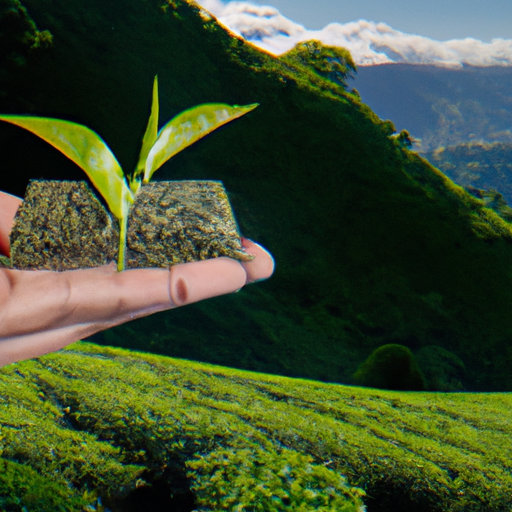Tea and Horticulture: The Symbiotic Relationship Between Gardens and Tea Growth
As we've clearly established in our past posts, tea holds a revered place in the hearts and minds of many—an elixir elevating monotony into art, evoking myriad emotions and experiences. While we relish the flavor melting on our tongue, it's essential to remember the roots literally tangled within the horticultural world. Let's "dive" into the symbiotic relationship between tea and gardens, from diverse plantations to picturesque landscapes, sharing the stage with the Camellia sinensis plant. So, steep in and let's explore!
The Roots: Exploring Tea-Integrated Gardens
Tea gardens vary dramatically, from uniform rows of tea bushes to stunning landscapes interspersed with various flora. Horticulturists have long recognized the benefits of incorporating tea plants within garden spaces, creating scenic landscapes rich in biodiversity.
| Tea-Integrated Gardens | Location |
|---|---|
| Darjeeling Tea Gardens | India |
| Hangzhou's Longjing Tea Village | China |
| Uji's Tea Fields | Japan |
| Azores Tea Plantations | Portugal |
| Tregothnan Tea Estate | England |
Take a "tea tour" through these remarkable global tea-integrated gardens that redefine the standard plantation aesthetic.
Darjeeling Tea Gardens, India
Nestled in the Indian Himalayas' foothills, Darjeeling's tea gardens are all about panoramic vistas and misty mountaintops. A breathtaking fusion of nature, the lofty slopes house tea plants alongside dense forests boasting diverse flora and fauna. This combination creates a unique terroir, earning Darjeeling tea the title of "Champagne of Teas."
Hangzhou's Longjing Tea Village, China
Home to China's prized Dragon Well tea or Longjing tea, Hangzhou's tea village embraces natural landscape integration. Staggered terraces flawlessly blend with bamboo forests, plum trees, and spring blossoms. Botanic harmony coupled with the village's history-laden culture has led to its listing as a UNESCO World Heritage Site.
Uji's Tea Fields, Japan
Renowned for its premium matcha and gyokuro, Uji's tea fields marry Japan's love for gardens with tea production. Uji embraces "shade cultivation," employing trees and structures to shade tea plants, resulting in teas' characteristic umami flavors. Tea gardens in Uji often feature streams, ponds, and Japanese maple trees, encapsulating the essence of Japanese landscaping aesthetics.
Azores Tea Plantations, Portugal
In the volcanic archipelago of Azores, tea plantations dot landscapes filled with lush forests, vibrant wildflowers, and mist-covered mountains. Gorreana Tea, Europe's oldest tea plantation, stands witness to the history and harmonious integration of tea and the Azorean surroundings.
Tregothnan Tea Estate, England
Located in Cornwall, England, the Tregothnan Estate is the first tea plantation in the UK. The estate cultivates the Camellia sinensis plant amid its grand 100-acre garden. Showcasing diverse flora, including ancient oaks and historic camellias, Tregothnan seamlessly implants English tea culture within the realm of horticulture.
Brewing Benefits: Tea and Garden Companionship
When tea plants share their stage with diverse flora, a mutualistic relationship emerges. Presented here are three crucial elements that knit together tea plants with their verdant companions.
-
Biodiversity: Greater plant diversity within tea gardens leads to a prosperous ecosystem hosting various flora and fauna. It helps nurture natural enemies of pests, reducing dependency on chemical pesticides, and encouraging sustainable practices.
-
Soil Health: Intercropping tea plants with other vegetation aids in preserving soil structure and quality. These companion plants play a vital role in reducing erosion, retaining moisture, and embracing natural nutrient cycling. Healthier soil ultimately results in more robust and flavorful tea plants.
-
Terroir: Plant diversity significantly impacts the terroir, the taste of tea influenced by the environment where the tea plants grow. The presence of other plants, flowers, trees, and soil attributes intertwine harmoniously, creating distinct flavor profiles for tea leaves, making them truly unique.
Tea Gardens: A Horticulturist's Cup of Inspiration
We conclude our garden exploration with the idea of creating your tea-inspired garden. Whether for aesthetics or endeavoring to grow Camellia sinensis, incorporate elements like bamboo, flowering shrubs, trees, and mossy pavers. Such enchanting spaces grant you the priceless opportunity to enjoy nature's symphony while sipping a freshly brewed cup of "tea-licious" tranquility.
Gardens and tea share an innate bond, steeped in symbiotic harmony. This musing barely scratches the surface of tea's horticultural complexity. So, we urge you to chime in and share your thoughts on this leafy liaison. Can you think of any standout tea gardens, or have tales of your tea-inspired landscaping? Let us know, and let's "cultivate" a flourishing discourse together in the comments below!
